Transfer Letter Template
[Your Name]
[Your Address]
[City, State, ZIP Code]
[Email Address]
[Phone Number]
[Date]
[Recipient's Name]
[Recipient's Title]
[Company/Organization Name]
[Company/Organization Address]
[City, State, ZIP Code]
Subject: Transfer Request
Dear [Recipient's Name],
I hope this letter finds you well. I am writing to formally request a transfer from my current position at [Current Department/Team] to [Target Department/Team] within [Company/Organization Name]. After careful consideration and discussion with my supervisor, I believe that this transfer will allow me to further contribute to the organization's success while also aligning with my career goals and aspirations.
I have thoroughly enjoyed my time working in [Current Department/Team] and am proud of the accomplishments and projects I have been a part of. However, I am excited about the opportunity to bring my skills and experience to [Target Department/Team], where I believe I can make a meaningful impact and continue to grow both personally and professionally.
I have already spoken with [Current Supervisor's Name] about my intentions, and they have expressed their support for my transfer request. Additionally, I have taken the time to discuss this potential move with [Target Department/Team Manager's Name], who has kindly agreed to consider my application.
I am confident that my experiences, knowledge, and dedication will enable me to excel in my new role within [Target Department/Team]. I am committed to a smooth transition process and will work closely with both teams to ensure minimal disruption to ongoing projects and responsibilities.
Please find attached my updated resume and any other necessary documents for your review. If there are any further steps or information required from my end to facilitate this transfer, please do not hesitate to let me know.
Thank you for considering my transfer request. I greatly appreciate the opportunities that [Company/Organization Name] has provided me, and I am enthusiastic about the possibility of continuing my journey here in a new capacity. I look forward to discussing this matter further at your earliest convenience.
Sincerely,
[Your Name]
[Your Employee ID, if applicable]
[Your Signature (if a physical copy is being submitted)]
Enclosure: Resume (if applicable)
Employee Transfer Request Letter
Subject: Request for Transfer to [Department/Location]
Dear [Manager/HR Director],
I am writing to formally request a transfer from my current position as [Current Position] in [Current Department] to [Desired Position] in [Desired Department/Location]. After [duration] in my current role, I believe this transfer would benefit both my professional development and the organization's objectives.
The primary reasons for my transfer request are [specific reasons - career growth, family circumstances, skill utilization, etc.]. I have thoroughly researched the requirements for the target position and believe my experience in [relevant skills/projects] makes me a suitable candidate.
I am prepared to undergo any necessary training and commit to a smooth transition period. My current projects can be completed by [date] or transferred to a colleague with proper documentation.
I would appreciate the opportunity to discuss this request in person and am available at your convenience. Thank you for considering my application.
Respectfully,
[Your Name]
[Current Position]
[Contact Information]
Student Transfer Letter
Subject: Application for Transfer to [School/Program Name]
Dear Admissions Committee,
I am currently enrolled as a [current year] student at [Current Institution] pursuing [Current Major/Program]. I am writing to request a transfer to your esteemed institution for the [semester/academic year] term.
My decision to transfer stems from [specific academic reasons, program availability, location, family circumstances]. Your institution's [specific programs/facilities/reputation] aligns perfectly with my academic and career objectives in [field of study].
My current GPA is [GPA] and I have completed [number] credit hours. I have been actively involved in [extracurricular activities, research, volunteer work] and believe I would contribute positively to your campus community.
Enclosed are my official transcripts, letters of recommendation, and completed application materials. I am committed to maintaining academic excellence and would be honored to continue my education at your institution.
Thank you for your time and consideration. I look forward to your response.
Sincerely,
[Your Full Name]
[Student ID]
[Contact Information]
Medical Patient Transfer Letter
Subject: Patient Transfer Request for [Patient Name]
Dear Dr. [Receiving Physician],
I am referring [Patient Name], DOB: [Date], for transfer to your facility for continued medical care. The patient is currently under my care at [Current Facility] and requires specialized treatment that would be best provided at your institution.
Current diagnosis: [Primary diagnosis and relevant secondary conditions]
Treatment provided: [Summary of current treatment, medications, procedures]
Reason for transfer: [Specific medical reasons, need for specialized care, equipment, etc.]
The patient's condition is [stable/critical/improving] and they are medically cleared for transfer via [ambulance/helicopter/private transport]. All medical records, imaging studies, and laboratory results are attached.
Please confirm receipt of this referral and advise on bed availability. For urgent matters, I can be reached at [phone number].
Thank you for accepting this transfer.
Dr. [Your Name]
[Medical License Number]
[Facility Name]
[Contact Information]
Property Transfer Letter
Subject: Property Transfer Documentation for [Property Address]
Dear [Recipient/Attorney/Title Company],
I, [Your Full Name], hereby formally document the transfer of property located at [Complete Property Address] from [Current Owner] to [New Owner] effective [Transfer Date].
Property Details:
- Legal Description: [Legal property description]
- Parcel Number: [Tax parcel number]
- Transfer Value: [Sale price or assessed value]
- Transfer Type: [Sale, gift, inheritance, etc.]
This transfer is being executed under the terms of [purchase agreement, will, gift deed, etc.] dated [date]. All liens, encumbrances, and financial obligations have been [resolved/transferred/assumed as specified].
Required documentation including deed, title insurance, and financial statements are attached. Please process this transfer according to local regulations and notify all relevant parties upon completion.
For questions regarding this transfer, please contact me at [contact information].
Sincerely,
[Your Signature]
[Printed Name]
[Date]
Military Transfer Orders Acknowledgment
Subject: Acknowledgment of Transfer Orders - [Service Member Name]
Dear [Commanding Officer/Personnel Office],
I hereby acknowledge receipt of my Permanent Change of Station (PCS) orders dated [Order Date], directing my transfer from [Current Base/Unit] to [New Assignment] effective [Report Date].
Order Details:
- Order Number: [Official order number]
- Current Assignment: [Current position and unit]
- New Assignment: [New position and unit]
- Report Date: [Date to report]
- Dependents: [Number] authorized to accompany
I understand my responsibilities regarding this transfer, including completing required check-out procedures, arranging household goods shipment, and reporting to my new duty station by the specified date.
I request [number] days of leave en route and will coordinate travel arrangements through the Transportation Management Office. My family and I are prepared for this relocation and appreciate the opportunity to serve at the new assignment.
Respectfully submitted,
[Your Signature]
[Rank and Name]
[Service Number]
[Contact Information]
Bank Account Transfer Letter
Subject: Request for Account Transfer - Account #[Account Number]
Dear [Bank Manager/Customer Service],
I am writing to request the transfer of my account(s) from [Current Branch] to [New Branch] due to [reason for transfer - relocation, convenience, service preferences].
Account Information:
- Account Holder: [Full Name]
- Account Number: [Account Number]
- Account Type: [Checking, Savings, etc.]
- Current Balance: [Amount]
- Monthly Activity: [Brief description]
I would like to maintain the same account numbers and features if possible. Please transfer all automatic payments, direct deposits, and standing orders to the new branch. I have notified relevant parties of this change, but please ensure continuity of all services.
I am available to visit either branch to complete necessary paperwork and would prefer to schedule this transfer for [preferred date]. Please advise on required documentation and procedures.
Thank you for your assistance in facilitating this smooth transition.
Sincerely,
[Your Signature]
[Printed Name]
[Account Holder ID]
[Contact Information]
Child Custody Transfer Message
Subject: Child Custody Transfer Schedule - [Child's Name]
Dear [Co-parent's Name],
I hope this message finds you well. I am writing to confirm the custody transfer arrangements for [Child's Name] as outlined in our custody agreement dated [Date].
Transfer Details:
- Transfer Date: [Specific date]
- Transfer Time: [Specific time]
- Pick-up Location: [Address or meeting point]
- Return Date: [When child returns]
- Duration: [Length of custody period]
[Child's Name] will have [his/her] overnight bag packed with clothes, medications, and comfort items. Please ensure [he/she] has completed homework and any scheduled activities during your custody time.
If you need to make any changes to this schedule, please provide at least [notice period] notice. In case of emergency, please contact me immediately at [emergency contact].
I want to ensure this transition is as smooth as possible for [Child's Name] and appreciate your cooperation in maintaining consistency.
Best regards,
[Your Name]
[Contact Information]
What is a Transfer Letter and Why Do You Need One
A transfer letter is a formal document that communicates the movement, relocation, or change of status of a person, object, property, or responsibility from one entity to another. These letters serve as official records, ensure proper documentation, facilitate smooth transitions, and protect all parties involved by clearly stating terms, conditions, and expectations.
Transfer letters are essential for:
- Creating legal documentation of changes
- Ensuring continuity of services or care
- Protecting rights and interests of all parties
- Meeting regulatory and institutional requirements
- Providing clear communication channels during transitions
Who Should Send Transfer Letters
Transfer letters should be sent by the party initiating or requesting the transfer:
- Employees requesting departmental or location changes
- Students applying for school or program transfers
- Medical professionals referring patients to other facilities
- Property owners documenting asset transfers
- Military personnel acknowledging reassignment orders
- Bank customers requesting account transfers
- Parents arranging custody transfers
- Legal representatives acting on behalf of clients
- Human resources departments processing internal transfers
- Administrative staff facilitating institutional changes
When Transfer Letters Are Required
Transfer letters become necessary during various triggering events:
- Career advancement or job relocation opportunities
- Educational program changes or academic progression needs
- Medical emergencies requiring specialized care or facilities
- Life changes such as marriage, divorce, or family circumstances
- Military deployment or permanent change of station orders
- Financial restructuring or banking convenience needs
- Legal requirements mandating documentation of asset transfers
- Organizational restructuring within companies or institutions
- Geographic relocation affecting multiple aspects of life
- Performance improvement necessitating role changes
How to Write and Send Transfer Letters
The process involves several critical steps:
- Assess the situation and determine specific transfer requirements
- Research recipient requirements and preferred communication methods
- Gather necessary documentation including forms, records, and supporting materials
- Draft the letter using appropriate tone and including all essential information
- Review and edit for accuracy, completeness, and professionalism
- Obtain required approvals or signatures from relevant authorities
- Choose appropriate delivery method (email, mail, hand delivery)
- Keep copies for your records and follow-up purposes
- Confirm receipt and schedule any necessary follow-up actions
- Monitor progress and address any complications promptly
Requirements and Prerequisites Before Sending
Essential preparations include:
- Valid identification and proof of authority to request transfer
- Complete documentation of current status, agreements, or contracts
- Financial clearance including payment of outstanding obligations
- Regulatory compliance with applicable laws and institutional policies
- Approval letters from supervisors, administrators, or legal guardians
- Medical clearances when health-related transfers are involved
- Academic transcripts for educational transfer requests
- Background checks for security-sensitive transfer situations
- Insurance verification and coverage transfer arrangements
- Timeline coordination with all affected parties
Formatting Guidelines for Transfer Letters
Proper formatting ensures professional presentation:
- Length: Keep letters concise but comprehensive (1-2 pages maximum)
- Tone: Match the formality level to the situation (professional for business, respectful for medical)
- Structure: Use clear paragraphs with logical flow from introduction to conclusion
- Language: Choose precise, unambiguous wording to prevent misunderstandings
- Headers: Include subject lines that clearly identify the transfer purpose
- Contact information: Provide multiple ways to reach you for questions
- Attachments: List all supporting documents and ensure they're included
- Signatures: Use appropriate signatures (handwritten for legal documents, electronic for business)
- Delivery method: Choose email for routine requests, certified mail for legal transfers
Follow-up Actions After Sending Transfer Letters
Post-submission responsibilities include:
- Confirmation tracking to ensure letter receipt and processing
- Response monitoring within expected timeframes
- Additional documentation submission if requested
- Interview scheduling or meeting arrangements when required
- Status updates to relevant parties affected by the transfer
- Contingency planning in case of transfer denial or complications
- Transition coordination including training, handovers, or orientation
- Address updates with all relevant organizations and contacts
- Service transfers for utilities, subscriptions, and ongoing commitments
- Final confirmations once transfer is completed successfully
Common Mistakes to Avoid
Frequent pitfalls that can complicate transfer processes:
- Insufficient notice not allowing adequate processing time
- Incomplete information missing crucial details or documentation
- Wrong recipient sending letters to incorrect departments or individuals
- Inappropriate tone using casual language for formal situations
- Missing deadlines failing to submit requests within required timeframes
- Inadequate follow-up not tracking progress or confirming receipt
- Poor timing submitting requests during busy periods or holidays
- Unclear objectives not specifying exact transfer requirements
- Forgotten attachments omitting supporting documentation
- No backup plans failing to prepare for potential rejections or delays
Advantages and Disadvantages of Transfer Letters
Pros:
- Creates official documentation trail
- Ensures clear communication between parties
- Protects legal rights and interests
- Facilitates smooth transitions
- Establishes accountability and responsibility
- Provides reference for future decisions
Cons:
- Time-consuming to prepare properly
- May require multiple approvals and processing steps
- Can create delays in urgent situations
- Potential for miscommunication or misunderstanding
- May involve fees or administrative costs
- Success depends on recipient cooperation and policies
Tips and Best Practices
Effective strategies for successful transfers:
- Start early to allow sufficient processing time
- Research thoroughly before submitting requests
- Use templates but customize for specific situations
- Maintain professional relationships throughout the process
- Keep detailed records of all communications and documents
- Be flexible with dates and arrangements when possible
- Prepare alternatives in case primary requests are denied
- Communicate regularly with all affected parties
- Stay organized with checklists and tracking systems
- Seek assistance from experts when dealing with complex transfers

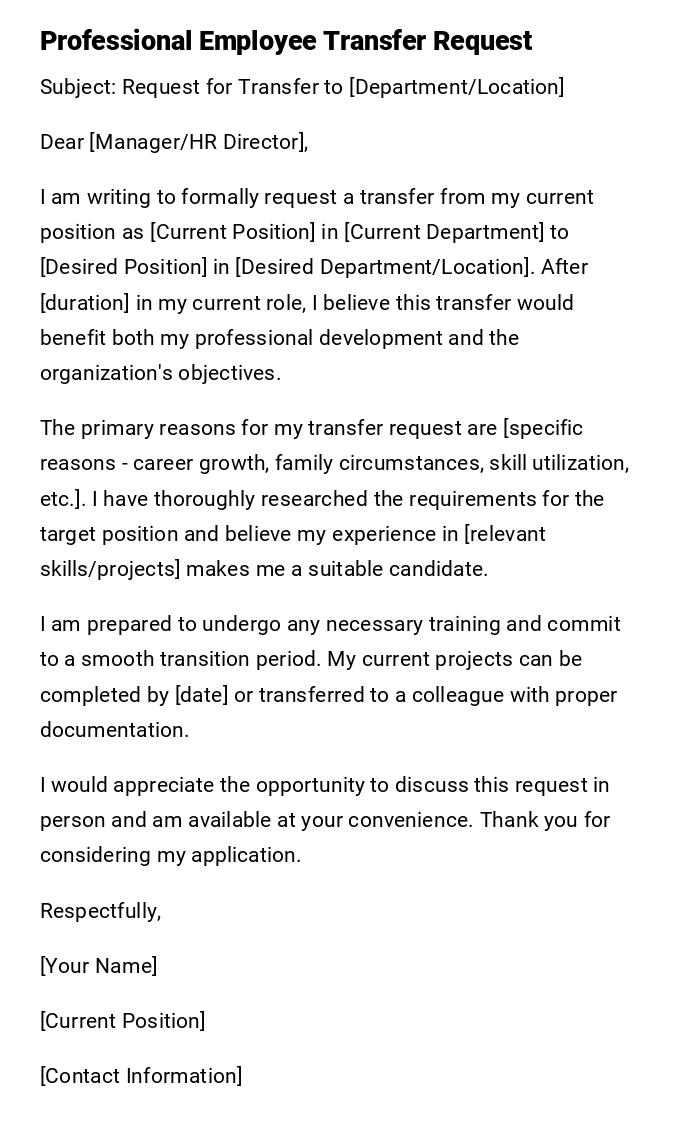
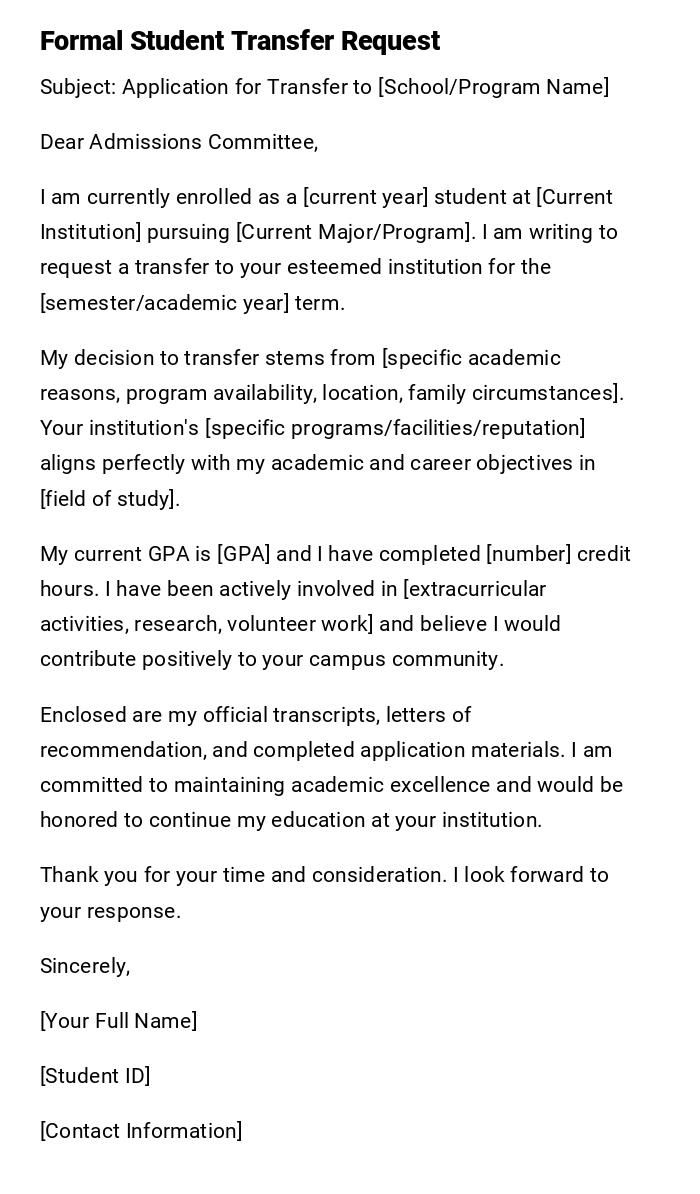
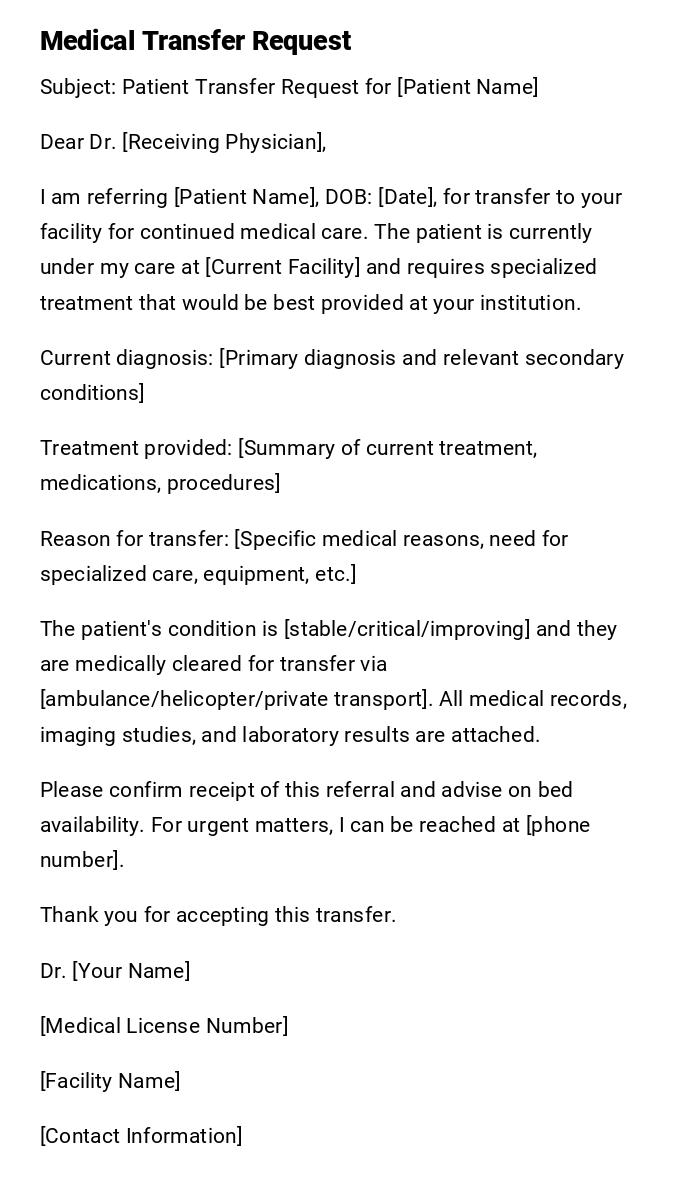
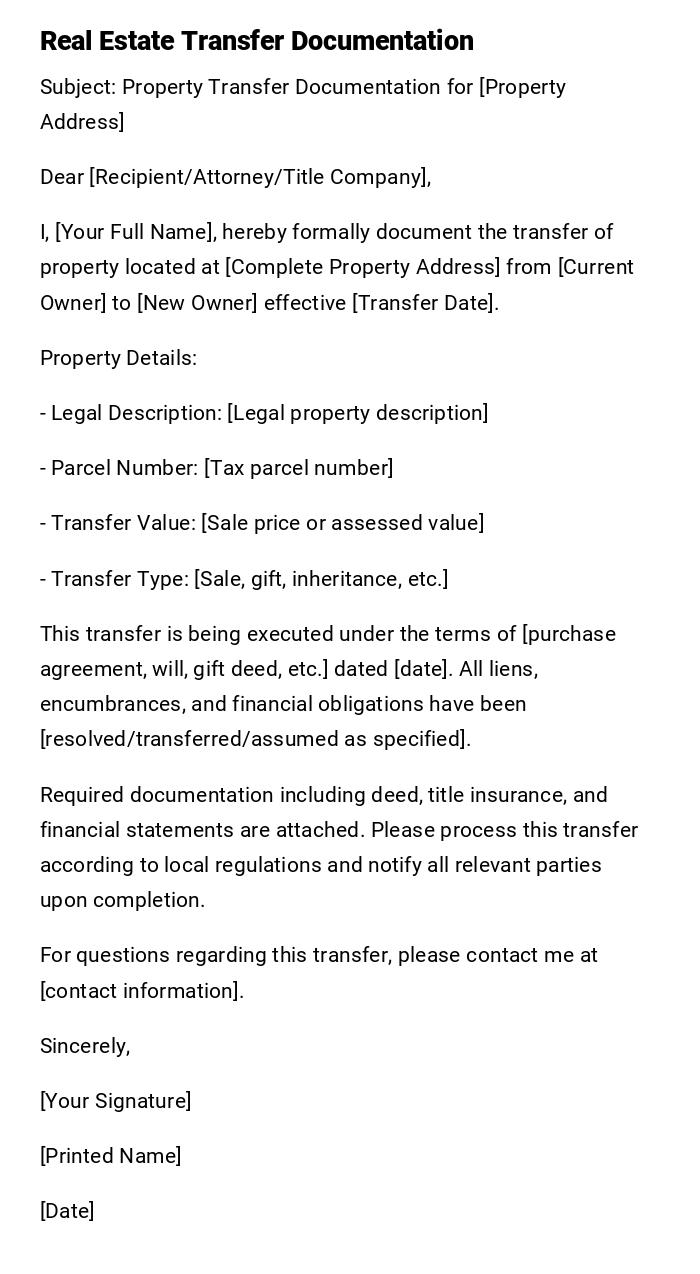
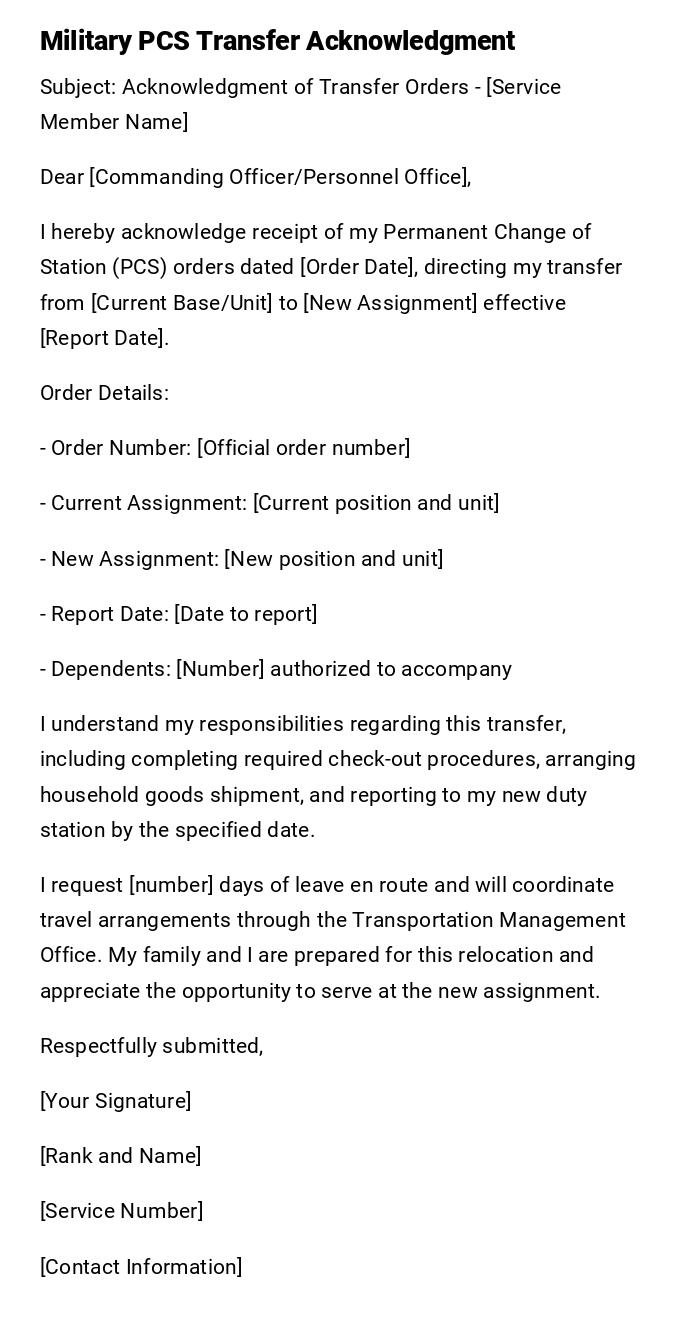
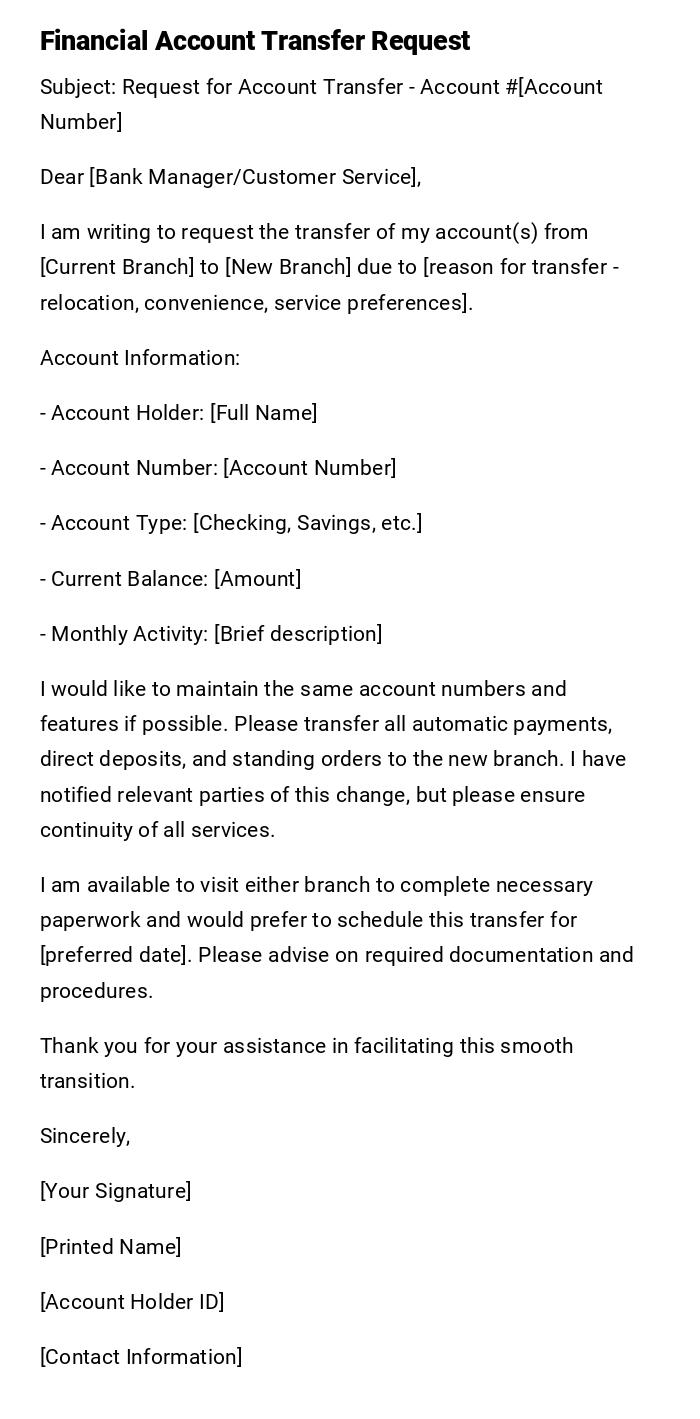
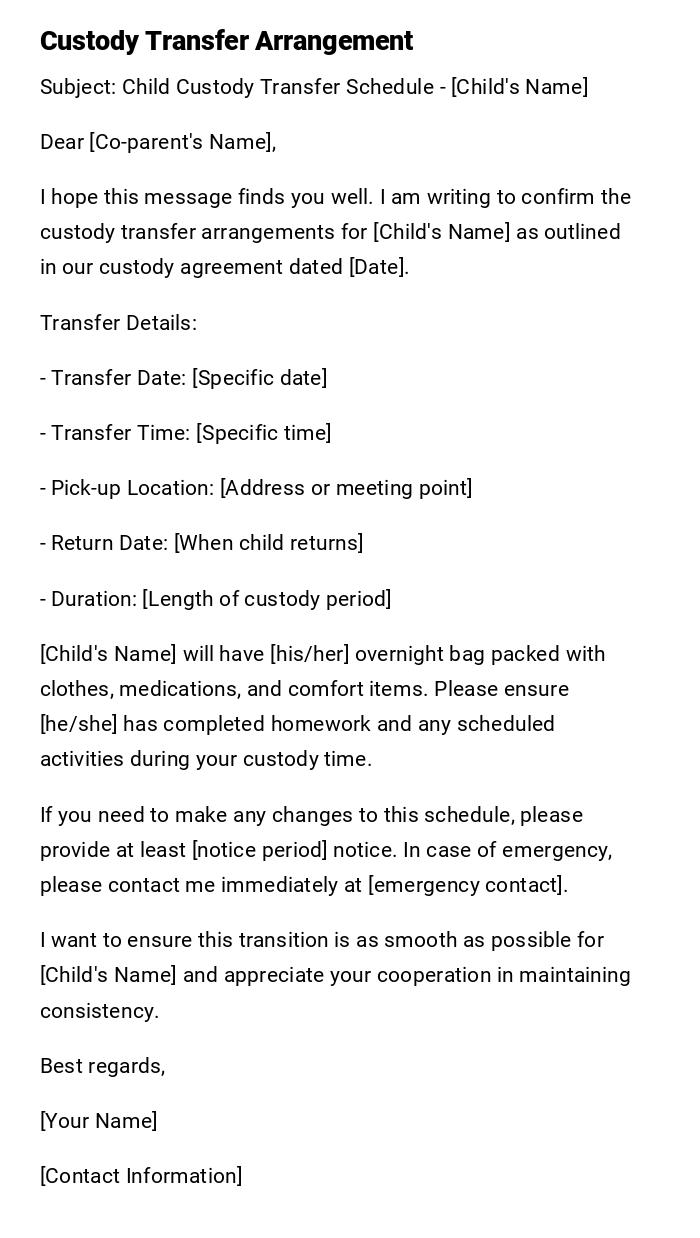
Bank Account Transfer Letter
Business Transfer Letter
Car Or Vehicle Transfer Letter
College Or University Transfer Letter
Fund Or Momey Transfer Letter Format
Gas Connection Transfer Letter Format
Insurance Transfer Letter
Job Transfer Letter
Lease Property Or Apartment Transfer Letter
Membership Transfer Letter
Name Transfer Letter Format
Salary Transfer Letter To Bank
School Transfer Letter
Share Transfer Letter Format
Stock Transfer Letter
Transfer Certificate Letter
Transfer Letter Of Credit
Transfer Letter Sample Another Location
Transfer Of Authority Letter
Transfer Of Guardianship Or Custody Letter
Transfer Of Ownership Letter
Transfer Of Rights Letter
Transfer Recommendation Letter
Wire Transfer Letter

 Download Word Doc
Download Word Doc
 Download PDF
Download PDF